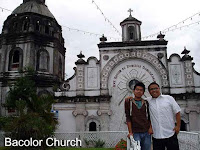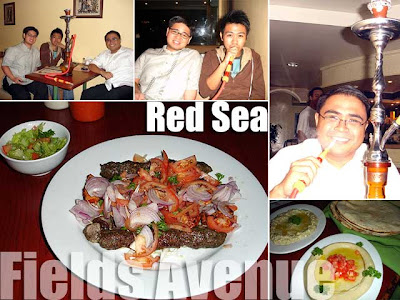
Today was Hari Raya Aidiladha, a public holiday in Malaysia. And my SSEAYP batchmate Kenneth invited me to join their road trip to Ipoh in the state of Perak, some 205 kilometers north of Kuala Lumpur. With so much chocolate tickling my taste buds yesterday, the food trip today was a most welcome sequel.

Kenneth passed by for me in KL then we motored back to Klang where the rest of the group was meeting up. And as soon as we were complete, we had the local specialty called
bak kut teh. He has always been raving about the
bak kut teh of Klang, widely believed to be the home of this Hokkien-style herbal pork broth which translates as “pork bone tea.”
It’s a complex mixture of several herbs and spices, about ten I was told, boiled with pork ribs for hours! They served us
youtiao (strips of fried dough) which was so tasty especially when dipped in the soup. The dish which is served in a claypot had other ingredients such as mushrooms, tofu and lettuce. And it’s eaten with rice.

We also tried out the dry
bak kut teh which is less common but equally tasty. That is stir-fried meat with okra, dried chilies, and dark soy sauce. But the unique ingredient in this dish is dried cuttlefish. After that sumptuous breakfast, we were off.
Road travel in Malaysia is very convenient since there is a complex network of highways linking peninsular Malaysia from north to south and east to west. So the drive to Ipoh, roughly the distance between Manila and Dagupan, can be completed in less than three hours. And since it was a smooth drive, I was able to cat nap. And the next thing I knew, we were already exiting at Sungkai, a small town south of Ipoh.

We drove several kilometers further through vast palm oil plantations before reaching our destination, the Sungai Klah Hot Springs Park, said to be one of the best managed hot springs in Malaysia.

A healing center nestled at the foothills of the Titiwangsa Range, the park attracts both locals and foreigners who seek a cure to various ailments such as skin disease, rheumatism, arthritis, insomnia, respiratory troubles, and blood circulation. Being a popular destination, it gets crowded on weekends and holidays. And since we were there on a holiday, it was jam-packed with people. I was not able to pack my swimming gear since it was a business trip after all. So I was content with dipping my feet in 50° Celsius sulfuric water.

The temperatures in the different pools varied and were clearly marked since areas where the hot water bubbled up from the ground can reach a scalding 102° Celsius! In fact, those areas have been designated for boiling eggs. The hot water is said to emerge from 500 areas in the complex. A boardwalk was built parallel to these boiling streams so that people could enjoy the sulfur-rich steam that seeped through the gaps in between the planks while walking along the path. I was also tempted to try out their spa which offered the traditional Ayurveda treatments. But I didn’t want to get too oily since we still had a long day ahead, so I had to pass.
I actually skipped lunch since we were still full from the late breakfast we had in Klang. Although I had a
cendol drink while in the park. After a few hours, we were off to Ipoh.
Part 2:
Old town kopi tiam of IpohPart 3:
Mamak food rocks!Part 4:
Seremban stopover
 Since we're on the topic of Malaysia, I realized that I still have some pending entries from my June trip to Malaysia, Indonesia and Singapore. One of the cities I got to visit was Seremban, the capital of the state of Negeri Sembilan south of KL.
Since we're on the topic of Malaysia, I realized that I still have some pending entries from my June trip to Malaysia, Indonesia and Singapore. One of the cities I got to visit was Seremban, the capital of the state of Negeri Sembilan south of KL. It was my second time here. The last time was during SSEAYP 2002 since my host family in Malaysia was from there. This time, my host family insisted that I visit them before I returned for the Philippines. So I took a 10 a.m. bus from Singapore and arrived in Seremban at about 3 p.m.
It was my second time here. The last time was during SSEAYP 2002 since my host family in Malaysia was from there. This time, my host family insisted that I visit them before I returned for the Philippines. So I took a 10 a.m. bus from Singapore and arrived in Seremban at about 3 p.m.















































